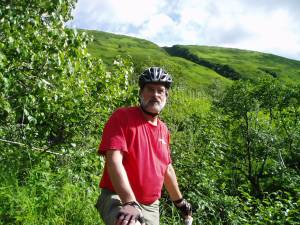 EDITOR’S NOTE: In honor of National Bike To Work Week on May 14-18, we will be running a series of features of bike commuters who work at the Alaska Native Tribal Health Consortium, Southcentral Foundation and Alaska Native Medical Center in Anchorage and the SouthEast Alaska Regional Health Consortium in Sitka. Thank you to Laura Kotelman of Southcentral Foundation for supplying the Anchorage profiles (written by Janice Swier) and SEARHC for the Sitka profile (note, most profiles appeared previously in newsletters for the various organizations).
EDITOR’S NOTE: In honor of National Bike To Work Week on May 14-18, we will be running a series of features of bike commuters who work at the Alaska Native Tribal Health Consortium, Southcentral Foundation and Alaska Native Medical Center in Anchorage and the SouthEast Alaska Regional Health Consortium in Sitka. Thank you to Laura Kotelman of Southcentral Foundation for supplying the Anchorage profiles (written by Janice Swier) and SEARHC for the Sitka profile (note, most profiles appeared previously in newsletters for the various organizations).
 James Temte, Assistant Consultant of Environmental Health Support and Management Operations Support at the Alaska Native Tribal Health Consortium, believes in the words of John F. Kennedy, “Nothing compares to the simple pleasure of riding a bike.”
James Temte, Assistant Consultant of Environmental Health Support and Management Operations Support at the Alaska Native Tribal Health Consortium, believes in the words of John F. Kennedy, “Nothing compares to the simple pleasure of riding a bike.”
Using his bike as a mode of transportation has been something Temte has been doing since he was young. When Temte was a child his mother would make him ride his bike to school every day. The activity became something Temte looked forward to and he has continued to use his bike as a mode of transportation in adulthood.
“I like to enjoy a bike ride daily,” Temte says of commuting to work by bicycle. Temte admits that scheduling extra time to bike versus drive can be difficult at first, but starting off your day with fresh air and saving money on gas are both reasons that make the adjustment worth it.
Temte encourages those thinking of starting to commute by bicycle to schedule a few extra minutes so they don’t have to rush on their bike ride and can really enjoy it, “Bike commuting should be fun. Allow enough time to enjoy the ride; then it won’t be a drag.”
Temte has enjoyed Bike to Work events in the past and is volunteering this year with Team Alaska Native Medical Campus (Team ANMC) in planning many of their Bike to Work Week activities. “Bike to Work activities are totally a bonus. The Blueberry Breakfast and the Bike Bash should be fun, I’ll be there.” Temte said of some the events that will take place on ANMC this year during Bike to Work Week.









You must be logged in to post a comment.